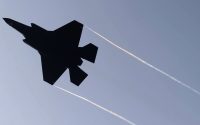The Death of a Treaty Could Be a Lifesaver for Taiwan
During a military exercise with the Philippines that began last month, the U.S. Army deployed a new type of covert weapon that is designed to be hidden in plain sight.
Called Typhon, it consists of a modified 40-foot shipping container that conceals up to four missiles that rotate upward to fire. It can be loaded with weapons including the Tomahawk — a cruise missile that can hit targets on land and ships at sea more than 1,150 miles away.
The weapon, and other small mobile launchers like it, would have been illegal just five years ago under the 1987 Intermediate-Range Nuclear Forces Treaty, which prohibited U.S. and Russian forces from having land-based cruise or ballistic missiles with ranges between about 300 miles and 3,400 miles.
In 2019, President Donald J. Trump abandoned the treaty, in part because the United States believed Russia had violated the terms of the pact for years. But U.S. officials said that China, with its growing long-range missile arsenal, was also a reason the Trump administration decided to withdraw.
The decision freed the Pentagon to build the weapons that are now poised to defend Taiwan from a Chinese invasion. It also coincided with a rethinking of modern war by U.S. Marine Corps leaders. They recommended retiring certain heavyweight and cumbersome weapons like 155-millimeter howitzers and tanks — which they thought would be of little use against Chinese forces in the Pacific — and replacing them with lighter and more flexible arms like truck-mounted anti-ship missiles.
At the time, the Pentagon had no land-based anti-ship weapons. Other militaries, however, already did. Then in April 2022, Ukrainian ground troops used a similar weapon, Neptune anti-ship cruise missiles launched from trucks, to sink the Russian cruiser Moskva in the Black Sea.
Despite the success of the Moskva attack, a group of retired Marine generals publicly criticized the Corps’ plans to prioritize similar weapons at the expense of more traditional arms. They said the service was focusing on China to the detriment of other potential threats, and that getting rid of tanks and some heavy artillery would leave Marines unprepared for a major conflict in other parts of the world.
At a meeting of the Defense Writers Group in December 2022, Gen. David H. Berger, then the Marines’ top general, acknowledged that he had been criticized by former colleagues but said his decisions were informed by intelligence reports the retirees could not obtain.
U.S. military and civilian leaders believed that President Xi Jinping of China planned to follow through on his many pledges to reunite Taiwan with Beijing by diplomatic means, or by force if necessary. And the Moskva’s hull rusting on the seafloor pointed to a possible way to dissuade Beijing from military action.
Pentagon officials believed that deterring China would not require a missile like the newest Tomahawk, which can attack ships with the equivalent of about a half-ton of TNT, nor even one like Ukraine’s Neptune, which carries a warhead about a third of that size.
Instead, positioning even smaller missiles to disable Chinese frigates, destroyers and amphibious craft could be enough, U.S. officials came to think, given their belief that Mr. Xi would try to invade only if he believed he would succeed in a relatively bloodless operation before American troops responded.
Targeting officers selected a Navy missile called SM-6, for Standard Missile 6, that seemed right for the job.
With a warhead about half the size as the one carried by the Neptune, the SM-6 could evade a Chinese warship’s defenses and, on impact, change the crew’s mission from invasion to survival.
Setting squadrons of Chinese amphibious ships packed with troops ablaze in the Taiwan Strait, Pentagon officials believed, would not only protect the de facto independent island but may also make Mr. Xi’s own grip on power within the Communist Party untenable.
Without the legal restrictions of the I.N.F. Treaty, the Pentagon began experimenting with existing assets.
Sealed canisters containing Tomahawk and SM-6 missiles were mounted onto small trucks and hidden in shipping containers.
Publicly, the Navy says the missile has a maximum range of about 115 miles. But the SM-6 can in fact reach targets at ranges of 290 miles, officials confirmed to The New York Times, speaking on the condition of anonymity to discuss sensitive weapons capabilities.
In the event of hostilities with China, the Philippines could invoke its longstanding mutual defense pact with Washington, inviting U.S. forces to deploy mobile missile launchers to any of the nine Philippine military bases that the Pentagon has secured access to in the past decade.
Some of those partner bases are clustered on Luzon Island, where SM-6 missiles could threaten Chinese ships in the waterway between the northernmost reaches of the Philippines and Taiwan.
Last year the Pentagon gained access to a base on Balabac Island in southwestern Philippines. From there, the same weapon could reach China’s collection of militarized reefs in the Spratly Islands, which have become a major base of operations for Beijing’s efforts to control the South China Sea.
A new security agreement signed in August between Washington and Tokyo could offer a third strategic location for Taiwan’s defense in case of war — military bases in Japan’s far western Ryukyu chain. From one such facility on Yonaguni Island, where U.S. forces train with their Japanese counterparts, an SM-6 could hit any target surrounding Taiwan and threaten bases on the Chinese mainland right across the strait.
With the longer-range Tomahawk, truck-based launchers and Typhons secreted on small islands within a thousand miles of the Chinese mainland could largely obviate one of Beijing’s greatest perceived strengths: missiles developed in China that its military leaders claim could sink an American aircraft carrier sent to defend Taiwan.


